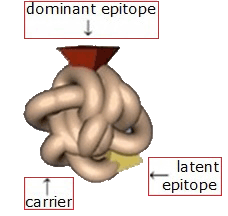Antigen is a substance triggering the immune responses to constitute memory to this antigen.
It is estimated that the "universe of antigens" make up about 1018 molecules in the environment.
Antigenicity, specificity, and immunogenicity structurally and functionally characterize antigens.
Antigenicity is the quality of an antigen to serve ligand for a receptor. The receptors for antigens
are T-cell receptor (TCR) and B-cell receptor (BCR).
Specificity is the antigen quality to be a unique molecule for only one receptor. An epitope or
antigenic determinant is an informational unit of the antigen specificity. In the antigen molecule, an epitope may
be dominant or latent. A carrier, the non-information part of the antigen molecule, is required for any antigen
to be complete.
Immunogenicity is the quality to induce the adaptive immune responses of different power.
The majority of antigens are T dependent since they require the participation of helper T cells to
constitute memory cells. T independent antigens are capable of activating mature B cells on their own.
In the past, there was a division of T independent antigens into two types: type 1 (currently they all refer to
pathogen-associated molecular patterns - PAMP) and type 2, which comprised highly repetitive surface epitopes, e.g., polysaccharides of
encapsulated bacteria. They induce only simple B-cell-mediated responses.
|

|

